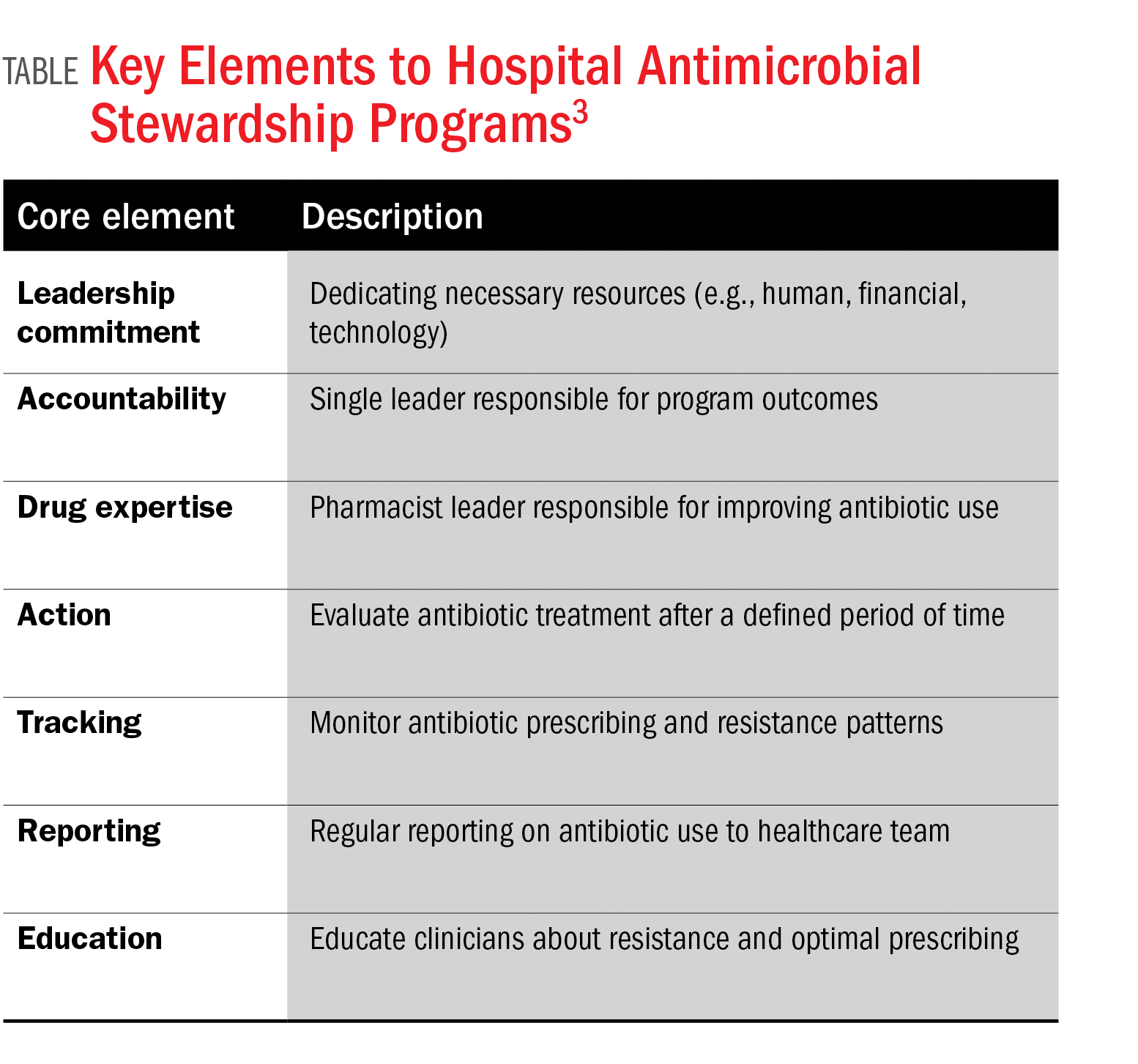Antimicrobial Stewardship: Protecting Global Health
Programs shown to improve patient outcomes, reduce antibiotic resistance, and decrease healthcare costs.

Lily Garcia, PharmD, BCPS

According to the Centers for Disease Control and Prevention (CDC), at least 2 million individuals are infected with antibiotic-resistant bacteria annually, resulting in more than 23,000 deaths. Antimicrobial stewardship programs offer strategies to improve appropriate antibiotic use, which can enhance patient outcomes and reduce adverse events. Pharmacists can play an important role through an interdisciplinary approach in the community and hospital settings.
More from this article: Antibiotic Counseling Pearls for the Community Setting
Judicious Use
Antibiotics can be lifesaving, but they must be used judiciously to prevent antimicrobial resistance that can ultimately lead to longer hospital stays, higher medical costs, and increased mortality. The World Health Organization (WHO) considers antimicrobial resistance to be one of the 10 threats to global health in 2019. A variety of infections including pneumonia, tuberculosis, gonorrhea, and foodborne illness are becoming more difficult to treat. Overuse and misuse of antibiotics are the driving forces contributing to AMR, and it can also lead to serious adverse events such as Clostridium difficile infections. One example is the widespread use of antibiotics for viral infections. According to a study published in the Journal of the American Medical Association (JAMA), at least 30% of antibiotics prescribed in the United States are unnecessary.1 Hospitals can also be affected by antimicrobial resistant infections. In a study published in Clinical Infectious Diseases, 399 patients were assessed for multidrug-resistant organisms (MDRO) from two hospitals.2 The study found that 14% of patients had MDRO present on them at baseline. Also, 10% of patients had an MDRO contained on their hands.2 This emphasizes the importance of patient hand hygiene to reduce the transmission of infections.
Trending: Generics and Biosimilars Facing Formulary Difficulties
Fighting Antibiotic Resistance
Fighting antimicrobial resistance in both the community and hospital settings is extremely important. Evidence demonstrates that antimicrobial stewardship programs improve patient outcomes, reduce antimicrobial resistance, and decrease healthcare costs. Pharmacists should educate patients and healthcare providers about antimicrobial resistance and appropriate use of antibiotics (See: Antibiotic Counseling: Pearls for the Community Setting).
Check with patients to ensure they are up-to-date on all recommended immunizations, as vaccine preventable diseases could cause infections that lead to antibiotic use. Pharmacists can administer any needed vaccines, which can help to reduce antibiotic resistance.
U.S. Antibiotic Awareness Week is Nov. 18-24, which is an annual observance to raise awareness of antimicrobial resistance and the importance of appropriate antibiotic prescribing and use. The CDC has provided free educational materials for patients, pharmacists, and other healthcare professionals (available at: cdc.gov/antibiotic-use/community/index.html).
The WHO has just launched the AWaRe tool with a goal to prevent antimicrobial resistance by classifying antibiotics into the following three groups: Access, Watch, and Reserve. The Access group indicates the first- and second-line options for each of the 25 most common infections that should be available at all times as well as affordable to the public. The WHO has a goal that by 2023, 60% of all antibiotics consumed should come from the Access group, since these medications have the lowest risk of antimicrobial resistance. For example, amoxicillin (Access group) is considered the drug of choice for strep throat. The Watch group includes first- and second-line antibiotics that should be used for a specific, limited number of infections. Finally, the Reserve group should only be used as a last resort for MDROs and be closely monitored. Colistin is often reserved for MDROs associated with pneumonia.
Continue reading on page 2...
Timothy Gauthier, PharmD, BCPS-AQ ID,

The Infectious Diseases Society of America has published evidence-based practice guidelines for evaluating antimicrobial stewardship programs and emphasizes the importance of physician and pharmacist leadership as well as infectious disease expertise. The need for antimicrobial stewardship programs has been recognized in the National Action Plan for Combating Antibiotic-Resistant Bacteria by the White House in March 2015, which calls for establishing antimicrobial stewardship programs in all acute care hospitals by 2020.
The structure of these programs is addressed in the CDC’s Core Elements of Hospital Antibiotic Stewardship Programs (See: Key Elements to Hospital Antimicrobial Stewardship Programs).3 Unfortunately, about a quarter to a half of all antibiotics prescribed in U.S. acute care hospitals are believed to be unnecessary or inappropriate.3
Patient Outcomes
Automatic changes from intravenous (IV) to oral antibiotic therapy when appropriate can improve patient safety. Fluoroquinolones, trimethoprim-sulfamethoxazole, and linezolid are some examples of antibiotics with good oral absorption. Renal dose adjustments for antibiotics are also important in patients with renal dysfunction. Other pharmacy interventions may include dose optimization, assessment for duplication of therapy, automatic stop orders, and prevention of antibiotic-related drug-drug interactions.
Antibiotic “time outs” are important since antibiotics are often initiated empirically while cultures are being obtained. After 48 hours, the treatment should be reviewed to determine if the antibiotic selected was appropriate and whether the dosage and duration of therapy are correct.3
Read More: 25 Cities with the Highest Pharmacist Salaries: 2018
Information technology staff can facilitate antimicrobial stewardship programs by incorporating drug information guidelines at the point of care, implementing clinical decision support tools for antibiotic use, and creating prompts for clinicians to review antibiotics. It is also critical to monitor antibiotic prescribing and report clinical interventions and outcomes to improve antibiotic use. Providing education that includes antibiotic drug information, patterns of antimicrobial resistance, and case studies can also play an integral role in the success of antimicrobial stewardship programs.
Resources for Pharmacists
Timothy Gauthier, PharmD, BCPS-AQ ID, is an antimicrobial stewardship and infectious diseases pharmacist practicing in Miami, FL who created the IDstewardship website, which provides pharmacists and other healthcare professionals with up-to-date information about antimicrobial resistance and antimicrobial stewardship programs. The content is written by experts in the area and is divided into three main free open-access sections. The resource center is geared toward those interested in antimicrobial stewardship programs and provides links to open-access institutional antimicrobial stewardship program websites, clinical practice resources, important guidelines, educational opportunities, learning activities for children, and much more.
“As someone obsessed with the topic, I frequently update this page with the latest and greatest stewardship resources (many of which these days are found via social media),” says Gauthier. The website includes articles written by experts about a variety of hot topics including residency and training, pharmacy news, and practical advice for pharmacists and students. The basic study guide is another resource with important talking points on various antimicrobial agents along with drug photos and links to relevant articles. There is also a section called IDstewardship Training at LearnAntibiotics.com.
Gauthier’s development of this digital resource was based on a perceived need in the pharmacy community. “It all started with Instagram, which I started using professionally in early 2014 after watching a show on PBS’s Frontline called “Generation Like.” This episode showed me that social media is the future, and I thought if we can combine this with pharmacy education and scholarship.
Continue reading on page 3...
Key Elements to Hospital Antimicrobial Stewardship Programs

Gauthier is passionate about IDstewardship and enjoys providing antibiotic expert information through writing in his free time as a creative outlet.
Gauthier provides insight into the global spread of antimicrobial resistance and the importance of reducing unnecessary antimicrobial use whenever possible by getting the right diagnosis, right drug, right dose, and right duration of treatment for infections. Antibiotics should not be prescribed when they are not needed, and when they are indicated, it is crucial to use them wisely. Pharmacists can play an important role in antimicrobial stewardship programs, and Gauthier contributed to the Society of Infectious Diseases Pharmacists outpatient care position statement on the topic.
“Pharmacists can promote awareness of the current antimicrobial resistance problems and encourage safe antimicrobial drug use. As a trusted member of society, pharmacists are well positioned to help (especially in this time where misinformation is so prolific on social media),” says Gauthier. “Pharmacists can also use their pharmacotherapy and healthcare systems expertise to improve care. This can be through developing resources, improving elements of practice, or making patient-specific interventions.”
Gauthier also discussed the future of antimicrobial stewardship and how the programs will continue to develop and expand as organizations such as The Joint Commission are making this a priority to fight antimicrobial resistance.
Trending: Preventing Errors with High-Risk Medications
“I believe pharmacists in all practice settings will play an increasingly important role in formalized antimicrobial stewardship program activities, and I hope IDstewardship can continue to be a valuable resource as this occurs,” says Gauthier.
Lily Garcia, PharmD, BCPS, is an infectious diseases clinical pharmacist specialist at Broward Health Medical Center (BHMC), in Ft. Lauderdale, FL. Garcia described that the antimicrobial stewardship program at BHMC aims to meet all of the seven core elements recommended by the CDC and includes pharmacists and physicians leading the program. Pharmacists provide their drug expertise to prescribers and perform daily interventions such as IV to oral dose conversions, renal dose adjustments, and vancomycin/aminoglycoside monitoring. “As an infectious diseases clinical specialist, I have an active role in new policy development and implementation as well as tracking and reporting of antimicrobial prescribing practices. I monitor hospital-wide antimicrobial use to ensure appropriate utilization of high cost/restricted antimicrobials and serve as a resource to my colleagues and physicians for appropriate prescribing and monitoring,” says Garcia.
Garcia is involved in training students and residents on clinical rotations. “The overuse and misuse of antimicrobials secondary to a lack of practitioner education and unlimited access to broad spectrum antibiotics are the greatest factors contributing to antimicrobial resistance.”
The decentralized pharmacist model at BHMC enables pharmacists to actively educate prescribers in real time about appropriate antimicrobial use. Garcia helped to develop hospital acquired infections (HAI) performance improvement committees that review patients with HAIs and provide guidance on how to manage these cases. Hospital staff are also provided with education through newsletters that include important information regarding antibiotic resistance, policy updates, and restricted antimicrobials.
References
1. Fleming-Dutra KE, Hersh AL, Shapiro DJ, et al. Prevalence of inappropriate antibiotic prescriptions among US ambulatory care visits, 2010-2011. JAMA. 2016;315(17):1864-1873.
2. Mody L, Washer LL, Kaye KS, et al. Multidrug-resistant organisms in hospitals: what is on patient hands and in their rooms? Clin Infect Dis. [Published April 13, 2019 ahead of print]. doi: 10.1093/cid/ciz092.
3. Core elements of hospital antibiotic stewardship programs. CDC website. https://www.cdc.gov/antibiotic-use/healthcare/implementation/core-elements.html. Accessed June 19, 2019.
